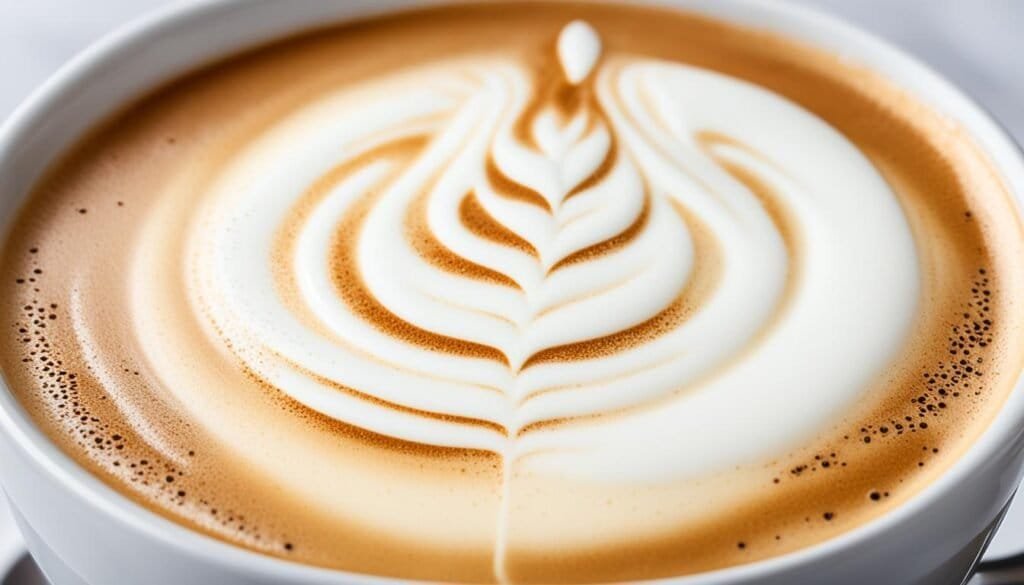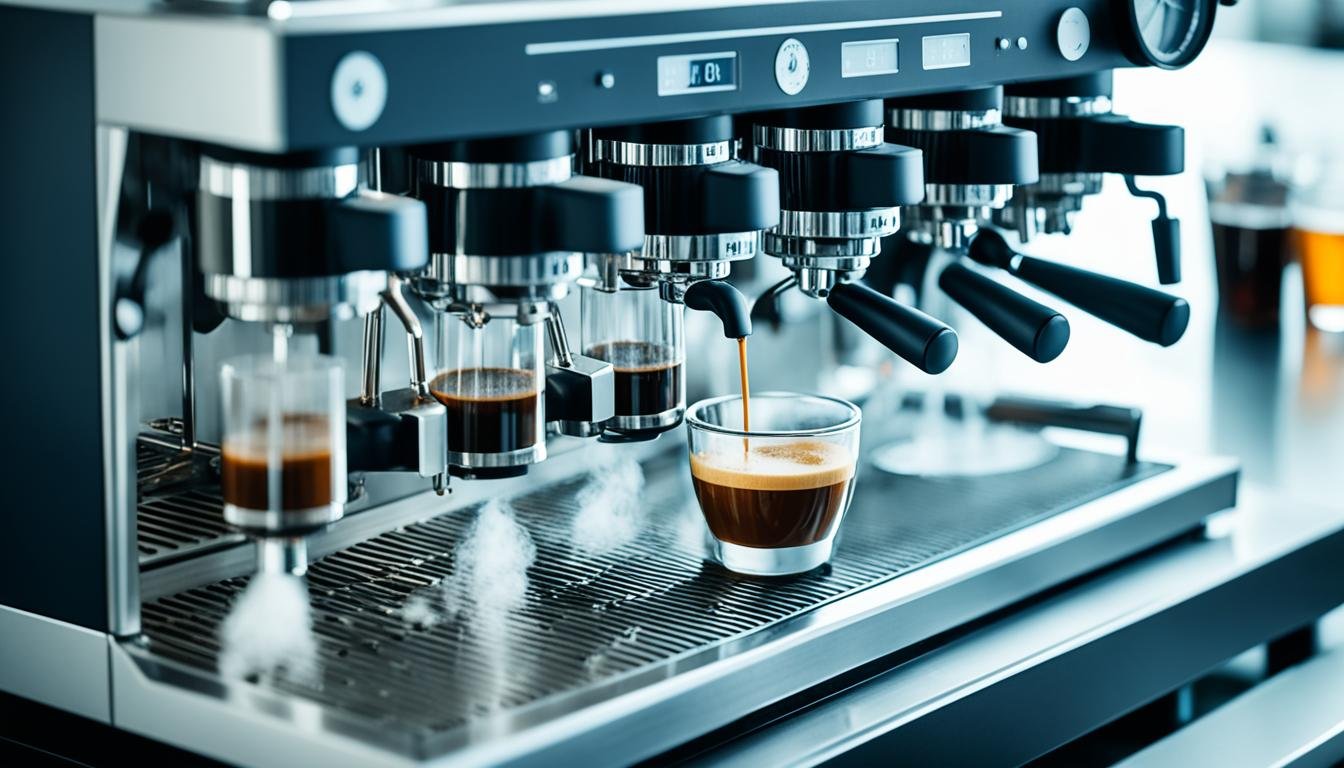Did you know that coffee is the second most consumed beverage in the world after water? It’s estimated that over 2.25 billion cups of coffee are consumed every day globally, with espresso being one of the most popular choices for coffee aficionados.
In this article, we will delve into the fascinating science behind creating the perfect espresso shot and achieving a creamy and delightful drink. From the chemistry behind crema formation to the factors that influence espresso shot quality, we’ll unravel the secrets of crafting the ultimate espresso experience.
Key Takeaways:
- Over 2.25 billion cups of coffee are consumed worldwide every day
- This article explores the science behind the perfect espresso shot and creamy drink
- We delve into the factors that affect espresso shot quality and the chemistry of crema formation
- Mastering the art of espresso brewing techniques can help you achieve a creamy and consistent drink
- Implementing barista tips and tricks can elevate your espresso game to new heights
Factors Affecting Espresso Shot Quality
When it comes to brewing the perfect espresso shot, several factors come into play. Each element contributes to the overall quality, taste, and texture of the final product. In this section, we will delve into the science behind espresso shot production and explore the key factors that affect its quality. Understanding these factors will help you unlock the secrets to brewing a truly exceptional espresso shot.
The Role of Coffee Beans
The type and grind size of the coffee beans play a crucial role in determining the flavor profile of your espresso shot. Different coffee bean varieties, such as Arabica or Robusta, can yield distinct taste characteristics. Additionally, the grind size affects the extraction process, allowing the water to come into contact with the coffee particles to extract the desirable flavors and oils.
Water Temperature and Pressure
Controlling the right water temperature and pressure is vital for producing an outstanding espresso shot. The water should be heated to around 195-205 degrees Fahrenheit (approximately 90-96 degrees Celsius) to ensure the extraction process extracts the desired flavors without over-extracting any bitter compounds. The pressure used during extraction also plays a role, typically ranging from 8 to 9 bars. This optimal pressure helps achieve the ideal balance between extracting the coffee’s aromatic compounds and avoiding any excessive bitterness.
The Science Behind Crema Formation
A hallmark of a well-crafted espresso shot is the creamy layer of crema that rests on top. The crema is formed by the emulsification of oils present in the coffee during the brewing process, creating a rich, golden foam. This layer not only adds visual appeal but also enhances the overall taste and texture of the espresso shot, contributing to a velvety mouthfeel.
To achieve the perfect crema, factors such as the freshness of the coffee beans, grind size, and the amount of dissolved solids in the beverage must be carefully balanced. Understanding the science behind crema formation can help you master the art of creating a flawless espresso shot with an exquisite crema layer.
Achieving Consistency with the Perfect Recipe
Creating a consistently exceptional espresso shot requires meticulous recipe breakdown. The ideal recipe involves precise measurements for the coffee dose, water volume, and extraction time. These variables, when carefully controlled, enable you to consistently reproduce the desired taste and quality of the espresso shot.
One common rule of thumb for a balanced espresso shot is using a coffee-to-water ratio of 1:2. This means using 18 grams of coffee to yield approximately 36 grams of liquid espresso. However, it is important to note that these ratios can be adjusted based on personal preference and brewing method.
Now that we’ve explored the key factors influencing espresso shot quality and examined the science behind crema formation, you are one step closer to crafting the perfect espresso shot. In the next section, we will dive deeper into mastering creamy drink consistency and reveal expert barista tips to elevate your espresso game.
Mastering Creamy Drink Consistency and Barista Tips
In this section, we will explore the art of creating creamy and consistent espresso-based drinks by leveraging coffee chemistry and expert barista tips. Whether you’re a coffee enthusiast or an aspiring barista, these techniques and brewing methods will help you elevate your espresso game and unlock the secrets to a rich and velvety drink.
The Perfect Brew: A Balance of Science and Technique
When it comes to brewing the perfect espresso shot, understanding the principles of coffee chemistry is paramount. The grind size, water temperature, and brewing time all play a crucial role in extracting the flavors and achieving a delectable taste.
To start, ensure that you have a coffee chemistry guide on hand. This guide will break down the key aspects of coffee chemistry and provide you with valuable insights into the ideal brewing techniques for different types of espresso. By following these guidelines, you can create a consistently delicious cup of espresso every time.
One crucial aspect of the brewing process is controlling the extraction time. Adjusting the extraction time allows you to fine-tune the flavors and strength of your espresso shot. Experiment with shorter or longer extraction times to find the perfect balance that suits your taste preferences.
Maintaining the right water temperature is another essential element in brewing espresso. High-quality espresso machines offer precise temperature control, ensuring that the water reaches the optimal range of 195-205°F (90-96°C) for extraction. Consistently monitoring and adjusting the water temperature will significantly impact the overall taste and quality of your espresso shot.
Mastering Milk Texture for Creamy Drinks
Creating creamy and luxurious espresso-based drinks goes beyond the espresso shot. Proper milk texturing techniques are crucial in achieving a velvety mouthfeel and enhancing the overall experience.
When steaming milk, it’s essential to consider two critical factors: temperature and texture. The ideal milk temperature for a creamy drink is around 150°F (65°C), which complements the flavors of the espresso without overpowering them. Steaming the milk at a higher temperature can result in a burnt taste, compromising the overall drink quality.
Texture plays a significant role in the feel and appearance of the drink. To achieve a velvety texture, focus on creating microfoam rather than large, airy bubbles. This microfoam will blend seamlessly with the espresso, resulting in a creamy and satisfying mouthfeel.

Expert Barista Tips for Espresso Perfection
Professional baristas have honed their craft over years of experience, and they possess valuable insights and tricks to unlock the true potential of espresso-based drinks. Here are some expert tips to help you achieve espresso perfection:
- Invest in high-quality coffee beans from reputable sources. The quality of the beans directly impacts the flavor and aroma of the final drink.
- Regularly clean and maintain your espresso machine to ensure optimal performance and consistency.
- Experiment with different coffee blends and origins to discover new and exciting flavors.
- Practice consistency in your brewing technique. Repeatable steps will lead to consistently excellent results.
- Continuously refine your skills and knowledge by attending barista courses and workshops.
By incorporating these barista tips into your espresso-making routine, you’ll be well on your way to creating coffee masterpieces that impress even the most discerning palates.
| Brewing Technique | Description |
|---|---|
| The Pour-Over | This method involves pouring hot water over a bed of coffee grounds in a filter, allowing for a slow and controlled extraction. |
| The French Press | A classic brewing method that involves steeping coffee grounds in water and then pressing them down with a plunger to separate the liquid from the grounds. |
| The Aeropress | A versatile brewing device that uses air pressure to extract flavors, resulting in a smooth and rich cup of coffee. |
Experimenting with different brewing techniques can be a fun and rewarding journey. Each method offers a unique flavor profile, allowing you to discover new dimensions of your favorite coffee beans.
Conclusion
Understanding the science behind the perfect espresso shot and creamy drink is crucial for coffee enthusiasts and aspiring baristas. By delving into the intricacies of espresso shot science, including factors like grind size, water temperature, and pressure, you can unlock the secrets to a truly exceptional espresso. Additionally, comprehending the chemistry behind crema formation will allow you to achieve that coveted velvety smooth texture that enhances the overall taste and aesthetic of your espresso shot.
Equally important is the implementation of barista techniques. By fine-tuning your extraction time, understanding the art of milk texturing, and learning from expert baristas, you can take your espresso brewing skills to the next level. These techniques, combined with the knowledge gained from this coffee chemistry guide, will help you consistently produce rich and creamy espresso-based drinks that rival those served in specialty cafés.
With the information shared throughout this article, you have all the tools you need to master the art of brewing the perfect espresso shot. By applying the principles of espresso shot science, appreciating the intricacies of crema formation, and incorporating professional barista techniques, you can create a coffee experience that brings joy and satisfaction to every sip. So go ahead, experiment with different beans, continue perfecting your craft, and enjoy the wonderful world of espresso brewing!
FAQ
What factors affect the quality of an espresso shot?
The quality of an espresso shot is influenced by several factors, including the type and grind size of the coffee beans, water temperature and pressure, extraction time, and the brewing equipment used.
How does crema form on top of an espresso shot?
Crema formation is a result of the emulsification of oils in the coffee beans during the brewing process. The pressure and temperature of the water passing through the coffee grounds cause these oils to dissolve, resulting in the creamy layer of foam we see on top of a well-made espresso shot.
What is the ideal recipe for the perfect espresso shot?
While there can be variations, the ideal recipe for a perfect espresso shot includes using freshly roasted and properly ground coffee beans, a water temperature between 195-205°F (90-96°C), a brew time of around 25-30 seconds, and an extraction ratio of roughly 1:2 (dose to yield).
What can I do to achieve a creamy and consistent drink every time?
To achieve a creamy and consistent drink, it is crucial to ensure the milk is properly textured, with small, velvety microfoam bubbles. Tapping and swirling the milk pitcher can help incorporate any larger bubbles and create a smooth texture. Additionally, paying attention to the extraction time and adjusting the grind size can also contribute to a consistent espresso flavor and creamy mouthfeel.
What are some barista tips for achieving espresso perfection?
Professional baristas recommend starting with fresh and high-quality coffee beans, regularly cleaning and maintaining the espresso machine, and dialing in the grind size to achieve the ideal extraction. They also emphasize the importance of weighing the coffee dose, timing the extraction, and experimenting with different brewing techniques to refine the flavor and crema of the espresso shot.




